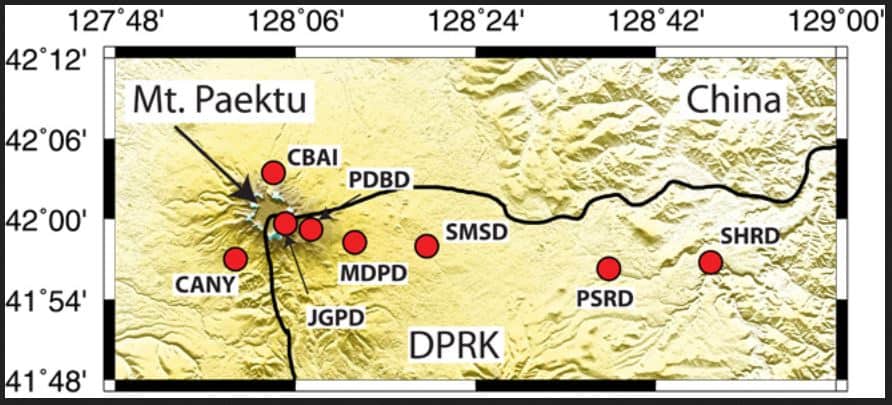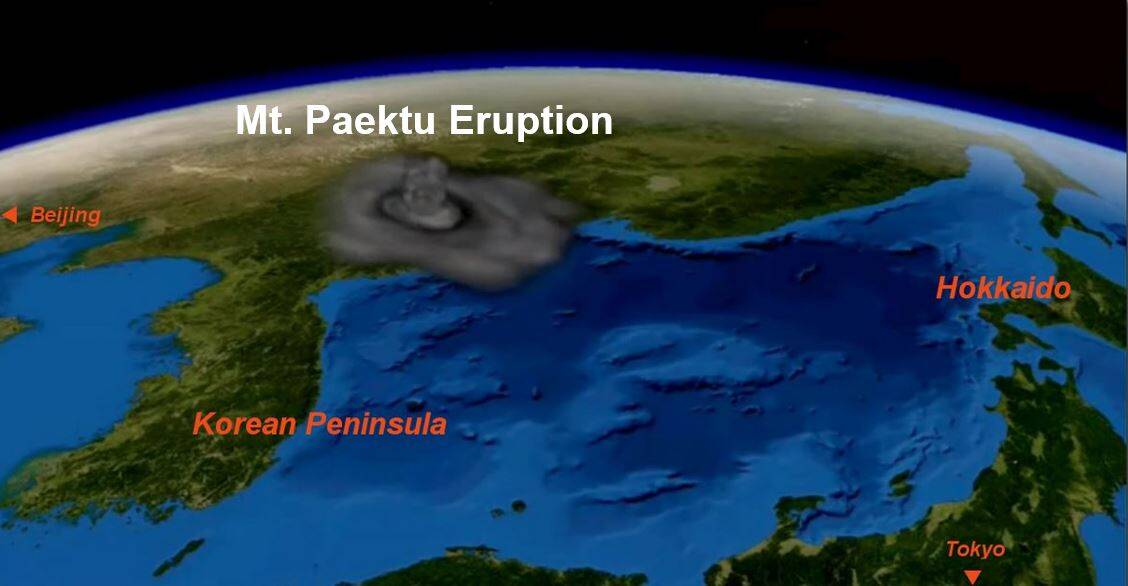The North Korean volcano – Mount Paektu – has significant molten rock underneath, adding to fears that it could blow at any time. It has done so before – about one thousand years ago (circa 946 AD) Mount Paektu, also known as Changbaishan, exploded with a ferocity rivaling the largest and most devastating eruptions in human history, spewing crackling rocks all the way to Japan.
An international team of scientists from North Korea, China, the United Kingdom and the United States, have carried out an extensive study of the volcano’s underbelly, and written about their findings in the journal Scientific Advances (citation below).
Co-author, Dr. James Hammond, who works at the Department of Earth and Planetary Sciences, Birkbeck College, University of London, and colleagues said their research and findings have furthered our understanding of the internal structure of this enigmatic volcano, which lies on the border of North Korea and China.
 Heaven Lake, a crater lake within a caldera atop Mount Paektu, a volcano that forms part of the Baekdudaegan mountain range and the Changbai mountain range. It is located partly in North Korea and northeastern China. (Image: Wikipedia)
Heaven Lake, a crater lake within a caldera atop Mount Paektu, a volcano that forms part of the Baekdudaegan mountain range and the Changbai mountain range. It is located partly in North Korea and northeastern China. (Image: Wikipedia)
Dr. Hammond, along with scientists from the Earthquake Administration in North Korea, the University of Cambridge’s Department of Geography, the Environmental Education Media Project in China, the US Geological Survey, and the Pyongyang International Information Centre of New Technology and Economy in North Korea, have seismically imaged beneath Mount Paektu’s crust.
Huge area of partial melt
The scientists showed seismic data that revealed a huge area of rock, molten rock and crystals, known as partial melt, directly under the volcano.
This partial melt may be linked to a significant increase in earthquake activity and emission of volcanic gases during the early years of this century, as well as holding the key to why Mt. Paektu erupted so violently about one thousand years ago.
Very little was known about the magma storage beneath the volcano, its rock composition and crust thickness – that is, until now.
Using ultra-sensitive, state-of-the-art equipment to record earthquakes – the first time such technology has been deployed in North Korea – the researchers have shown that the Earth’s crust directly beneath the volcano has been altered by the 3.5 million-year history of volcanism in the area.
 Station locations. Seismic stations used in the receiver function study (red circles). North Korean stations are Jang Gun Peak (JGPD), Paektu Bridge (PDBD), Mudu Peak (MDPD), Sin Mu Song (SMSD), Paek San Ri (PSRD), and Sing Hung Ri (SHRvD). (Image: Science Advances)
Station locations. Seismic stations used in the receiver function study (red circles). North Korean stations are Jang Gun Peak (JGPD), Paektu Bridge (PDBD), Mudu Peak (MDPD), Sin Mu Song (SMSD), Paek San Ri (PSRD), and Sing Hung Ri (SHRvD). (Image: Science Advances)
The area of partial melt is at least 20 kilometres (12.4 miles) wide, although its exact volume and size is still unknown.
Dr Hammond said:
“Volcanic eruptions, particularly those from volcanoes the size of Mt. Paektu, can have impacts far beyond their immediate surroundings. With increasing development and globalisation, our vulnerability to volcanic hazards is increasing. Therefore, we must give attention to understanding volcanoes, no matter where they are.”
“Our data indicate that the significant molten rock is present in the crust beneath Mt. Paektu. It is clear that further research into the volcano’s underlying structure is important to understand its recent and likely future activity.”
Dr. Hammond recently published a paper about scientific diplomacy and the difficulties of working in regions of the world where there are strained relationships within the international community.
In an Abstract in the journal, the authors wrote:
“This region of melt represents a potential source for magmas erupted in the last few thousand years and may be associated with an episode of volcanic unrest observed between 2002 and 2005.”
 One thousand years ago, Mt. Paektu erupted so fiercely that cracked rock fell as far as the Japanese island of Hokkaido. (Image: bjdeming.com)
One thousand years ago, Mt. Paektu erupted so fiercely that cracked rock fell as far as the Japanese island of Hokkaido. (Image: bjdeming.com)
It all started in 2011
Following a visit to the North Korean capital Pyongyang and Mt. Paektu in 2011, the international team of scientists has been developing an ambitious project with several organisations, and supported by the Richard Lounsbery Foundation, to carry out field-based volcanological and geophysical studies on the North Korean side of the border.
According to the University of Cambridge’s Department of Geography:
“This work stems in part from heightened interest in the volcano following episodes of increased seismicity beneath the volcano that was detected a decade ago.”
“The aims include imaging of the structure beneath the volcano to identify where magma is stored, and detailed studies of pumice samples to improve our understanding of the Millennium eruption.”
Citation: “Evidence for partial melt in the crust beneath Mt. Paektu (Changbaishan), Democratic People’s Republic of Korea and China,” Ri Kyong-Song, James O. S. Hammond, Ko Chol-Nam, Kim Hyok, Yun Yong-Gun, Pak Gil-Jong, Ri Chong-Song, Clive Oppenheimer, Kosima W. Liu, Kayla Iacovino and Ryu Kum-Ran. Scientific Advances. 15 April, 2016. DOI: 10.1126/sciadv.1501513.
Video – British scientists got inside North Korea to study volcano
